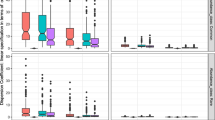Abstract
We propose to extend CART for bivariate marked point processes to provide a segmentation of the space into homogeneous areas for interaction between marks. While usual CART tree considers marginal distribution of the response variable at each node, the proposed algorithm, SpatCART, takes into account the spatial location of the observations in the splitting criterion. We introduce a dissimilarity index based on Ripley’s intertype K-function quantifying the interaction between two populations. This index used for the growing step of the CART strategy, leads to a heterogeneity function consistent with the original CART algorithm. Therefore the new variant is a way to explore spatial data as a bivariate marked point process using binary classification trees. The proposed procedure is implemented in an R package, and illustrated on simulated examples. SpatCART is finally applied to a tropical forest example.












Similar content being viewed by others
References
Anselin L, Getis A (2010) Spatial statistical analysis and geographic information systems, in Perspectives on spatial data analysis, vol 35–47. Springer, Berlin
Arlot S (2019) Minimal penalty and the slope heuristic: a survey (with discussion). Journal de la Société Française de Statistique 160(3):1–106
Baddeley A, Moller J, Waagepetersen R (2000) Non- and semiparametric estimation of interaction in inhomogeneous point patterns. Stat Neerl 54:329–350
Baudry JP, Maugis C, Michel B (2012) Slope heuristics: overview and implementation. Stat Comput 22(2):455–470
Bar-Hen A, Picard N (2006) Simulation study of dissimilarity between point process. Comput Stat 21(3–4):487–507
Bel L, Allard D, Laurent JM, Cheddadi R, Bar-Hen A (2009) CART algorithm for spatial data: application to environmental and ecological data. Comput Stat Data Anal 53(8):3082–3093
Breiman L, Friedman JH, Olshen RA, Stone CJ (1984) Classification and regression trees. Chapman & Hall, London
Chipman HA, George E, Laurent JM, McCulloch RE (2010) BART: Bayesian additive regression trees. Ann Appl Stat 4(1):266–298
Cressie N (1991) Statistics for spatial data. Wiley, New York
Diggle PJ, Chetwynd AG (1991) Second-order analysis of spatial clustering for inhomogeneous populations. Biometrics 47:1155–1163
Diggle PJ, Milne RK (1983) Bivariate Cox processes: some models for bivariate spatial point patterns. J R Stat Soc B 45:11–21
Favrichon V (1994) Classification des espèces arborées en groupes fonctionnels en vue de la réalisation d’un modèle de dynamique de peuplement en forêt guyanaise. Rev Ecol 49:379–403
Gey S, Lebarbier E (2008) Using CART to detect multiple change points in the mean. Preprint in Statistics and System Biology 12, HAL 00327146
Gourlet-Fleury S, Guehl JM, Laroussinie O (eds) (2004) Ecology and management of a neotropical rainforest: lessons drawn from Paracou, a long-term experimental research site in French Guiana. Elsevier, Paris
Haining R (2014) Bivariate correlation with spatial data. Geogr Anal 23(3):210–227
Hastie T, Tibshirani R, Friedman J (2009) The elements of statistical learning: data mining, inference, and prediction, 2nd edn. Springer, Berlin
Hofner B, Mayr B, Robinzonov N, Schmid M (1991) Model-based boosting in R: a hands-on tutorial using the R package mboost. Comput Stat 29(1–2):3–35
Loecher M and K Ropkins (2015) RgoogleMaps and loa: unleashing R graphics power on map tiles. J Stat Softw 63(4):1–18,
Lotwick HW, Silverman BW (1982) Methods for analysing spatial processes of several types of points. J R Stat Soc B 44(3):406–413
Ripley BD (1977) Modelling spatial patterns. J R Stat Soc Ser B (Methodological) 172–212
Traissac S (2003) Dynamique spatiale de Vouacapoua americana (Aublet), arbre de forêt tropicale humide à répartition agrégée. PhD Thesis. Université Claude Bernard-Lyon 1, Lyon
Umlauf N, Klein N, Zeileis A (2018) BAMLSS: Bayesian additive models for location, scale, and shape (and beyond). J Comput Graph Stat 27(3):612–627
Wagner M, Zeileis A (2019) Heterogeneity and spatial dependence of regional growth in the EU: a recursive partitioning approach. Ger Econ Rev 20(1):67–82
Acknowledgements
The authors thank the Associate Editor and two anonymous referees for their valuable comments which led to a considerable improvement of the presentation.
Author information
Authors and Affiliations
Corresponding author
Additional information
Publisher's Note
Springer Nature remains neutral with regard to jurisdictional claims in published maps and institutional affiliations.
Rights and permissions
About this article
Cite this article
Bar-Hen, A., Gey, S. & Poggi, JM. Spatial CART classification trees. Comput Stat 36, 2591–2613 (2021). https://doi.org/10.1007/s00180-021-01091-6
Received:
Accepted:
Published:
Issue Date:
DOI: https://doi.org/10.1007/s00180-021-01091-6




